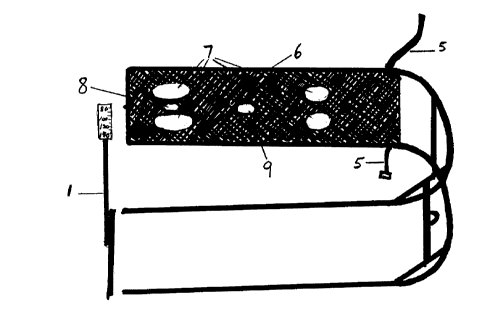Note: Descriptions are shown in the official language in which they were submitted.
CA 02261319 1999-02-11
S~C1FICAtlOri
This invention relates the transportation, processing
and weighing of ncvvborn catvcs.
'There are many tools for transporting, processing
and weighing of calvcsbut most are only capable of doing one or two of the
tasks mentioned. There often inefficient, awkward and may need two
people to operate. Common tools for transporting new born cah~es, have
the calves lying on the device low to the ground or up to high for cow to
recognize her calf. It is important that the cow is able to recognize her
calf;
or she wl'll not follow when the calf is being transported. If the calf is
raised
up off the ground she wont see it , and if it's transported to low she may
cause injury to her calf by accidentally stepping on it.
New bores are often processed on the ground with
the farmer kneeling on the calf to hold it down, or has the help of someone
else. This technique gets both the farmer, and the calf dirty, and puts the
farmer in danger of being injured by the calf or cow. Other systems for
securing calves for processing often need two people to operate and have
the calf laying on it's side, which makes it difficult to castrate because
gravity is not helping to drop the testicles. The head is lying on it's side
making it difficult to ear tag, or dehorn on the bottom side of the head.
Systems for weighing calves are often bullcy and
need two people to operate and may be easily damaged from rough
handling.
I have found that these problems have been over
conic by having one tool to do all throe jobs, transporting, weighing, and
processing. The calf sleigh moves easr'ty through snow, mud, manure, and
dry ground. It can travol up and down stops and through door ways. The
calf is up off the ground and in a natural position. 'The calls legs and head
are secured, but his head and body are fully exposed for processing, due to
the fact the calf is laying on his chest, and stomach the testicles are forced
down malting castration easier. The calfs head is in a up right position at a
comfortable working height malting tagging, tattooing, dehorning, or
administer oral medication a simple process. The weighing mechanism is
the sleigh itself it won't be damaged by the elements or rough treatment.
The imrentions description, and operation will riow
follow with referenncxs to the accompanying drawings.
Fig. # 1 is a side view of calf sleigh with detachable
scale bar ( 1 ).
CA 02261319 1999-02-11
Fig.#2 is front view of sleigh showing removable
tool/medicine box.(2) Also shown is the sleeve (3) to store scalc bar in.
Rope (4) for towing is also shown.
Transportation of the calf is done by lifting the calf up and
onto the deck (6), with the calls legs put through the 4 holes (7) on the
deck. Now the calf is suspended off the ground, safe from injury. The calf
is clearly visfble with it's legs under him in a natural position, the cow
thinks
~e calf is running away and readily follows.
Once in the calf sleigh, one pennon can easily process the
calf: The calls head is secured in a natural position by an adjustable
ion ~P (5)~ P~ just behind the head where the neck begins. The
catPs ears, horns, mouth, neck and body are easily accessible for ear
tatrooin~ dehorning, giving ~ medication, injections and
f branding.
The deck has two additional holes, one for the testicles (8)
and one for the navel (9). Pressure from the weight of the calf lying on its
stomach, forces the testicles into the scrotum, making it easy to castrate.
The calf s naval is exposed through a hole (9) in the deck. This reduces the
chance of transmitting disease from calf to calf through naval
contamination. The exposed naval makes naval disinfecting possible.
Due to the unique design, the deck (6) flexes in proportion
to the weight of the calf.
A calibrate bar (1), placed at the back of the deck (6), will indicate
the calls weight. On the front of the calf sleigh is a removable
tool/medicine box (2). It holds all the tools and medicines needed to
process the calf.
To rcntovc the calf from the icwcntion, aimpty tip the alcigh on ita
side and slide the sleigh away from the calf. The calf's legs will sfide out
of
the holes.
